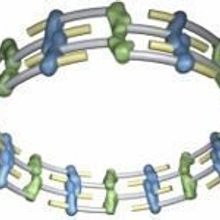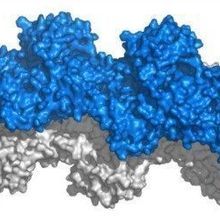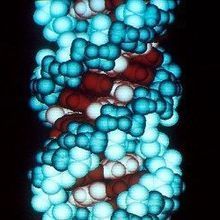protein structure

Spike Structure Gives Insight into SARS-CoV-2 Evolution
Abby Olena, PhD | Jul 16, 2020 | 3 min read
Researchers demonstrate that the SARS-CoV-2 spike protein is more stable and binds the human ACE2 receptor with much higher affinity than the spike protein of its closest known relative, bat coronavirus RaTG13.

Crowdsourced Protein Simulation Exceeds Supercomputers’ Power
Shawna Williams | Apr 15, 2020 | 2 min read
Folding@Home, currently focused on deciphering the workings of SARS-CoV-2, is the first project to have exascale-level computational muscle.

Nobel-Winning Biochemist Paul Boyer Dies
Shawna Williams | Jun 7, 2018 | 2 min read
The UCLA researcher was lauded for figuring out how ATP synthase works.

Unknown Protein Structures Predicted
Ruth Williams | Jan 19, 2017 | 3 min read
Metagenomic sequence data boosts the power of protein modeling software to yield hundreds of new protein structure predictions.

Video: Inner Circle
The Scientist | Nov 30, 2016 | 1 min read
See an animation that illustrates emerging insights into the inner ring structures of the nuclear pore complex.

Fraudulent Paper Pulled
Bob Grant | Jan 5, 2016 | 1 min read
Nature retracts a study six years after an investigation found that the protein structures it reported were fabricated.

Getting Back in Shape
Karen Zusi | Dec 1, 2015 | 3 min read
Contrary to years of research suggesting otherwise, most aggregated proteins regain their shape and functionality following heat shock.

Cas9 Proofreads Gene Edits
Karen Zusi | Nov 13, 2015 | 2 min read
The gene-editing CRISPR/Cas9 system has three checkpoints to ensure it alters the right section of DNA.

The Handedness of Cells
Kerry Grens | Jun 17, 2015 | 1 min read
Actin—the bones of the cell—has a preference for swirling into a counterclockwise pattern.

Screening Goes In Silico
Carina Storrs | Feb 1, 2015 | 8 min read
Computational tools take some of the cost—and guesswork—out of drug discovery.

RNA Puts Proteins in a Headlock
Kerry Grens | May 20, 2014 | 1 min read
A noncoding RNA initiates translation by grabbing hold of repressor proteins and restricting their functions.

Toxin Evolution
Abby Olena, PhD | Jan 16, 2014 | 1 min read
Researchers show that scorpion venom toxins are closely related to defensive proteins from venomous insects.

G-Protein Receptor Work Wins Nobel
Dan Cossins | Oct 9, 2012 | 3 min read
Robert J. Lefkowitz and Brian K. Kobilka take home this year’s Nobel Prize for Chemistry for revealing how membrane receptors sense and respond to chemical signals.
Painting the Protein Atomic, 1961
Sabrina Richards | Aug 1, 2012 | 2 min read
Irving Geis’s revolutionary painting of sperm whale myoglobin illuminated the nascent field of protein structure.
Molecular Blueprints
Cristina Luiggi | Mar 27, 2012 | 3 min read
Check out the latest crop of high-resolution structures and how they inform biological function.
Reading Tea Leaves
Jef Akst | Feb 1, 2012 | 3 min read
Cyclic peptides, discovered in an African tea used to speed labor and delivery, may hold potential as drug-stabilizing scaffolds, antibiotics, and anticancer drugs.
Rommie Amaro: Protein Explorer
Tia Ghose | Feb 1, 2012 | 3 min read
Assistant Professor, Department of Chemistry and Biochemistry University of California, San Diego. Age: 34
